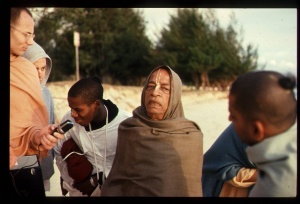SB 5.16.9: Difference between revisions
m (1 revision(s)) |
(Vanibot #0054 edit - transform synonyms into clickable links, which search similar occurrences) |
||
| (One intermediate revision by one other user not shown) | |||
| Line 1: | Line 1: | ||
{{info | {{info | ||
|speaker= | |speaker=Śukadeva Gosvāmī | ||
|listener=King | |listener=King Parīkṣit | ||
}} | }} | ||
[[Category:Srimad-Bhagavatam - Canto 05 Chapter 16|s09 ]] | |||
[[Category:Bhagavatam Verses Spoken by Sukadeva Gosvami - Vanisource|051609]] | |||
<div style="float:left">'''[[Srimad-Bhagavatam]] - [[SB 5|Fifth Canto]] - [[SB 5.16: A Description of Jambudvipa|Chapter 16: A Description of Jambūdvīpa]]'''</div> | |||
<div style="float:right">[[File:Go-previous.png|link=SB 5.16.8]] '''[[SB 5.16.8]] - [[SB 5.16.10]]''' [[File:Go-next.png|link=SB 5.16.10]]</div> | |||
{{RandomImage}} | |||
==== TEXT 9 ==== | ==== TEXT 9 ==== | ||
<div class="verse"> | |||
<div | :evaṁ dakṣiṇenelāvṛtaṁ niṣadho hemakūṭo himālaya | ||
evaṁ dakṣiṇenelāvṛtaṁ niṣadho hemakūṭo himālaya iti prāg-āyatā yathā nīlādayo 'yuta-yojanotsedhā hari-varṣa-kimpuruṣa-bhāratānāṁ yathā-saṅkhyam | :iti prāg-āyatā yathā nīlādayo 'yuta-yojanotsedhā | ||
:hari-varṣa-kimpuruṣa-bhāratānāṁ yathā-saṅkhyam | |||
</div> | </div> | ||
| Line 14: | Line 21: | ||
==== SYNONYMS ==== | ==== SYNONYMS ==== | ||
<div class="synonyms"> | |||
<div | ''[//vanipedia.org/wiki/Special:VaniSearch?s=evam&tab=syno_o&ds=1 evam]'' — thus; ''[//vanipedia.org/wiki/Special:VaniSearch?s=dakṣiṇena&tab=syno_o&ds=1 dakṣiṇena]'' — by degrees to the southern side; ''[//vanipedia.org/wiki/Special:VaniSearch?s=ilāvṛtam&tab=syno_o&ds=1 ilāvṛtam]'' — of Ilāvṛta-varṣa; ''[//vanipedia.org/wiki/Special:VaniSearch?s=niṣadhaḥ&tab=syno_o&ds=1 niṣadhaḥ] [//vanipedia.org/wiki/Special:VaniSearch?s=hema&tab=syno_o&ds=1 hema]-[//vanipedia.org/wiki/Special:VaniSearch?s=kūṭaḥ&tab=syno_o&ds=1 kūṭaḥ] [//vanipedia.org/wiki/Special:VaniSearch?s=himālayaḥ&tab=syno_o&ds=1 himālayaḥ]'' — three mountains named Niṣadha, Hemakūṭa and Himālaya; ''[//vanipedia.org/wiki/Special:VaniSearch?s=iti&tab=syno_o&ds=1 iti]'' — thus; ''[//vanipedia.org/wiki/Special:VaniSearch?s=prāk&tab=syno_o&ds=1 prāk]-[//vanipedia.org/wiki/Special:VaniSearch?s=āyatāḥ&tab=syno_o&ds=1 āyatāḥ]'' — extended to the east; ''[//vanipedia.org/wiki/Special:VaniSearch?s=yathā&tab=syno_o&ds=1 yathā]'' — just as; ''[//vanipedia.org/wiki/Special:VaniSearch?s=nīla&tab=syno_o&ds=1 nīla]-[//vanipedia.org/wiki/Special:VaniSearch?s=ādayaḥ&tab=syno_o&ds=1 ādayaḥ]'' — the mountains headed by Nīla; ''[//vanipedia.org/wiki/Special:VaniSearch?s=ayuta&tab=syno_o&ds=1 ayuta]-[//vanipedia.org/wiki/Special:VaniSearch?s=yojana&tab=syno_o&ds=1 yojana]-[//vanipedia.org/wiki/Special:VaniSearch?s=utsedhāḥ&tab=syno_o&ds=1 utsedhāḥ]'' — ten thousand yojanas high; ''[//vanipedia.org/wiki/Special:VaniSearch?s=hari&tab=syno_o&ds=1 hari]-[//vanipedia.org/wiki/Special:VaniSearch?s=varṣa&tab=syno_o&ds=1 varṣa]'' — the division named Hari-varṣa; ''[//vanipedia.org/wiki/Special:VaniSearch?s=kimpuruṣa&tab=syno_o&ds=1 kimpuruṣa]'' — the division named Kimpuruṣa; ''[//vanipedia.org/wiki/Special:VaniSearch?s=bhāratānām&tab=syno_o&ds=1 bhāratānām]'' — the division named Bhārata-varṣa; ''[//vanipedia.org/wiki/Special:VaniSearch?s=yathā&tab=syno_o&ds=1 yathā]-[//vanipedia.org/wiki/Special:VaniSearch?s=saṅkhyam&tab=syno_o&ds=1 saṅkhyam]'' — according to number. | ||
</div> | </div> | ||
| Line 22: | Line 28: | ||
==== TRANSLATION ==== | ==== TRANSLATION ==== | ||
<div class="translation"> | |||
<div | |||
Similarly, south of Ilāvṛta-varṣa and extending from east to west are three great mountains named (from north to south) Niṣadha, Hemakūṭa and Himālaya. Each of them is 10,000 yojanas [80,000 miles] high. They mark the boundaries of the three varṣas named Hari-varṣa, Kimpuruṣa-varṣa and Bhārata-varṣa [India]. | Similarly, south of Ilāvṛta-varṣa and extending from east to west are three great mountains named (from north to south) Niṣadha, Hemakūṭa and Himālaya. Each of them is 10,000 yojanas [80,000 miles] high. They mark the boundaries of the three varṣas named Hari-varṣa, Kimpuruṣa-varṣa and Bhārata-varṣa [India]. | ||
</div> | </div> | ||
__NOTOC__ | |||
<div style="float:right; clear:both;">[[File:Go-previous.png|link=SB 5.16.8]] '''[[SB 5.16.8]] - [[SB 5.16.10]]''' [[File:Go-next.png|link=SB 5.16.10]]</div> | |||
__NOTOC__ | |||
__NOEDITSECTION__ | |||
Latest revision as of 22:08, 18 February 2024

A.C. Bhaktivedanta Swami Prabhupada
TEXT 9
- evaṁ dakṣiṇenelāvṛtaṁ niṣadho hemakūṭo himālaya
- iti prāg-āyatā yathā nīlādayo 'yuta-yojanotsedhā
- hari-varṣa-kimpuruṣa-bhāratānāṁ yathā-saṅkhyam
SYNONYMS
evam — thus; dakṣiṇena — by degrees to the southern side; ilāvṛtam — of Ilāvṛta-varṣa; niṣadhaḥ hema-kūṭaḥ himālayaḥ — three mountains named Niṣadha, Hemakūṭa and Himālaya; iti — thus; prāk-āyatāḥ — extended to the east; yathā — just as; nīla-ādayaḥ — the mountains headed by Nīla; ayuta-yojana-utsedhāḥ — ten thousand yojanas high; hari-varṣa — the division named Hari-varṣa; kimpuruṣa — the division named Kimpuruṣa; bhāratānām — the division named Bhārata-varṣa; yathā-saṅkhyam — according to number.
TRANSLATION
Similarly, south of Ilāvṛta-varṣa and extending from east to west are three great mountains named (from north to south) Niṣadha, Hemakūṭa and Himālaya. Each of them is 10,000 yojanas [80,000 miles] high. They mark the boundaries of the three varṣas named Hari-varṣa, Kimpuruṣa-varṣa and Bhārata-varṣa [India].